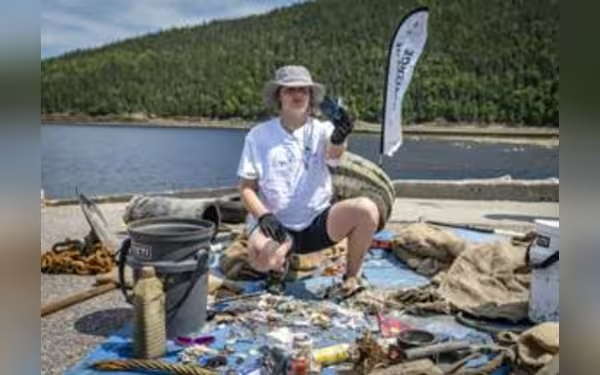Saturday, November 16, 2024 11:41 PM
Canadian Biologist Tackles Plastic Waste in Saguenay Fjord
- Plastic waste threatens Saguenay Fjord's marine ecosystem.
- Cigarette butts are the most common type of waste found.
- Microplastics pose serious risks to marine life.
 Image Credits: nation_pk
Image Credits: nation_pkCanadian biologist Anne-Marie Asselin leads efforts to combat plastic waste in the Saguenay Fjord, highlighting its impact on marine life.
In recent years, the issue of plastic waste has become a pressing concern worldwide, affecting even the most pristine environments. One such area is the Saguenay Fjord in eastern Canada, a marine protected area that has been a sanctuary for belugas and other whales for 26 years. Despite its protected status, the fjord is not immune to pollution, as old tires, discarded cups, and cigarette butts can be found littering its beautiful shores. This situation raises an important question: "How do we maintain the integrity of protected areas?"
Canadian biologist Anne-Marie Asselin, along with her team from the Blue Organization, is on a mission to tackle this issue head-on. They are diving into the fjord's brackish waters to document the pollution and understand its sources. Their research has a dual purpose: first, to identify the most common types of waste, particularly plastics that should be banned from sale, and second, to predict which areas are most at risk of pollution based on water currents. This information is crucial for planning effective cleaning campaigns.
During their cleanup efforts, Asselin and her crew collect various types of waste, sorting them meticulously by over 100 criteria, including brand names. Laurence Martel, a member of the team, highlighted the alarming prevalence of cigarette butts, stating, "The most popular find is the cigarette butt; it is omnipresent." This is particularly concerning because a single cigarette butt can contaminate up to 500 liters of water due to the toxic chemicals it contains.
Over the past five years, the team's research has uncovered a troubling trend: the concentration of plastic waste is significantly increasing closer to the Gulf of Saint Lawrence and the Atlantic Ocean. This suggests a shift in waste from urban areas to downstream parts of the river, which could have serious implications for marine life.
Martel further explained, "Very often, the smallest plastics are the ones that pollute the most." As waste breaks down, it becomes microplastics, which are tiny particles that can be as small as one thousandth of a millimeter. These microplastics are often invisible to the naked eye and can be found throughout the food chain, particularly affecting invertebrates.
To assess the health of the marine ecosystem, the Blue Organization studies these "sentinel species" during their cleanup operations. Miguel Felismino from McGill University emphasized the importance of this research, stating, "If your mussels and your invertebrates are starting to suffer, that could be an indicator that the health of the ecosystem is also declining." He meticulously measures and analyzes mussel specimens to understand the effects of microplastics on marine life.
As Felismino collects surface water and sediment from the seabed, it becomes clear that the fight against plastic pollution is far from over. The efforts of Asselin and her team highlight the need for greater awareness and action regarding plastic waste, even in the most remote and protected areas. It serves as a reminder that every individual has a role to play in preserving our environment. By reducing plastic use and participating in cleanup efforts, we can all contribute to the health of our planet's precious ecosystems.













